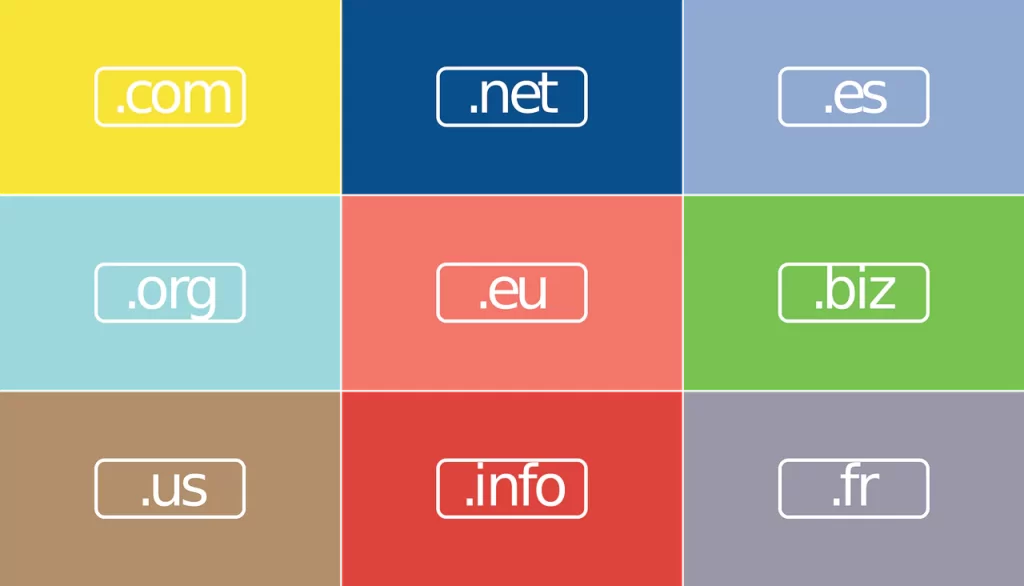The Ultimate Top-Level Domain List: Finding the Perfect Match for Your Website

Attention website owners and digital adventurers! Are you on the lookout for the perfect web address to stake your claim in the vast online realm? Well, you’ve come to the right place. In this article, we will explore the fascinating world of top-level domains (TLDs) and assist you in discovering the ideal TLD match for your website. So, without further ado, let us embark on this enlightening journey to unravel the secrets of TLDs.
Now, you might be wondering, “What the heck are these TLDs, and why do they matter?” Well, TLDs are those little bits at the end of a web address, like .com, .org, or .net. They play a crucial role in shaping your website’s identity on the vast internet. And who decides what TLDs exist? That’s where the Internet Assigned Numbers Authority (IANA) steps in.
IANA, known as the Internet’s naming guru, holds the responsibility for managing the vast and diverse world of top-level domains (TLDs). This includes overseeing their creation and maintenance to maintain order and coherence in the online realm. Acting as the gatekeeper, IANA diligently evaluates and grants or denies new TLDs akin to a discerning bouncer at an exclusive party. Ultimately, one can find the authoritative list of top-level domains with IANA.
What is a Top Level Domain (TLD)?
Ever wondered what a top level domain (TLD) really is? Well, picture it as that tiny snippet lingering at the end of a website address, such as .com or .org. These TLDs hold tremendous significance for your online presence, making the right choice absolutely pivotal. In the following section, we’ll delve into the nitty-gritty of TLDs—what they are, how they function, and the various types you ought to be aware of. Prepare yourself for uncovering the mysteries behind TLDs and propelling your website to new heights!

Definition of TLDs
Have you ever wondered about those top level domains we often mention? Picture them as the older siblings of website addresses. They serve as the final segment of a domain name, such as .com or .org. TLDs play a starring role in the internet, representing various categories and purposes.
TLDs form an integral part of one’s online identity. They carry significant weight in shaping the perception and discoverability of a website among users. The selection of an appropriate TLD can contribute to establishing credibility and attracting the intended audience, akin to choosing the perfect outfit for leaving a lasting impression. d
TLDs come in different types. There are generic ones like .com, .net, and .org that have wide-ranging applications and are widely used. Additionally, there are country-specific TLDs such as .us, .uk, or .de which allow for targeting specific regions effectively. Furthermore, there exist specialized TLDs like .edu for educational institutions or .gov exclusively reserved for government entities.
Each top-level domain serves a unique purpose and possesses distinct characteristics. Some TLDs enjoy popularity among businesses, while others find favor among non-profit organizations. Additionally, certain TLDs cater specifically to different industries. The key lies in selecting a TLD that aligns harmoniously with your website’s goals and target audience.
The Importance of TLDs in Today’s World
In today’s digital landscape, the significance of top level domains (TLDs) cannot be overstated. They serve as powerful indicators of credibility, relevance, and purpose for websites. In a sea of billions of websites, it is vital to stand out from the crowd, and choosing the right TLD can greatly aid in achieving that goal.
TLDs, or top-level domains, play a crucial role in establishing trust and credibility. When users come across familiar and widely recognized TLDs like .com or .org, it immediately instills confidence in their minds. It’s akin to receiving a seal of approval that assures visitors, “This website is legitimate!”
TLDs offer the advantage of targeting specific regions or audiences. For instance, country-specific TLDs like .us or .uk directly imply that your website caters to a particular geographic location. Consequently, this enhances your visibility in local search results and attracts relevant visitors.
Additionally, utilizing industry-specific TLDs can serve as a clear indicator of your website’s niche. For instance, if you operate an online store, incorporating a .store TLD can promptly convey your emphasis on e-commerce. This approach aids users in rapidly comprehending the purpose of your website and attracting the appropriate target audience.
From an SEO standpoint, the choice of TLDs can impact search engine rankings. While they aren’t the sole determining factor, search engines do take into account the relevance of TLDs to the search query. Aligning your TLD with your content and target keywords can provide a slight advantage in the rankings competition.
In the digital world, having a unique top level domain can greatly distinguish your online brand. Amidst the vast sea of websites, a TLD such as .io or .me adds memorability and distinctiveness. It injects personality and creativity into your online presence, setting you apart from competitors.
The Foundation of The Ultimate Top-Level Domain List
When faced with numerous top-level domains to choose from, it can feel overwhelming to identify the ideal one for your website. This is where IANA steps in! They offer a comprehensive list of all available top-level domains, serving as a convenient one-stop-shop for your domain search adventure.
The Role of the Internet Assigned Numbers Authority
Now, let us explore the captivating realm of the Internet Assigned Numbers Authority (IANA). This esteemed organization holds the pivotal role of overseeing all facets pertaining to the internet. From managing IP addresses to administering domain names, they adeptly handle it all.
In the past, Jon Postel managed IANA at USC under a contract with the US Department of Defense. However, since 1998, ICANN, a nonprofit American corporation, has taken over this responsibility. ICANN plays a crucial role in effectively managing IANA and ensuring smooth operations.
One of the super important tasks undertaken by IANA is managing domain names. They bear the responsibility for overseeing the root nameservers, which are situated at the pinnacle of the Domain Name System (DNS) hierarchy. Picture it as an immense tree with domain names branching out, and IANA firmly established at its very apex!
However, there is more to IANA. In addition to handling various tasks, such as DNSSEC key management, that may sound technical, it primarily focuses on ensuring the security of the internet. To guarantee tight security measures, IANA organizes signing ceremonies wherein trusted community representatives generate keys to keep everything locked down securely.
Moreover, the Internet Assigned Numbers Authority (IANA) assumes responsibility for managing the “int” registry intended for international treaty organizations and overseeing the “arpa” domain allocated to internet infrastructure, specifically reverse DNS service. These experts work behind-the-scenes, ensuring seamless functionality of the internet.
When it comes to compiling a comprehensive list of top-level domains, IANA is the trusted authority. They possess an intimate knowledge of the internet’s inner workings, ensuring seamless connectivity and organization. With IANA, your website’s domain harmoniously integrates with the broader web landscape.
Types of Top-Level Domains According to IANA
In 2015, the Internet Assigned Numbers Authority (IANA) categorized top-level domains into specific groups. These groups
Infrastructure top-level domain (ARPA)
The Infrastructure Top-Level Domain, commonly referred to as ARPA, serves a unique and technical role within the online realm. Its purpose is specific and distinct.
ARPA differs from common top-level domains such as .com or .org, as it serves a crucial function within the framework of the internet’s infrastructure. Its role is integral and essential to maintaining connectivity and functionality.
The domain in question serves the purpose of Address and Routing Parameter Area. It is widely used by various protocols, applications, and services. One of its primary functions involves facilitating reverse DNS lookups. To explain further, when you input a website’s URL into your browser, it translates the domain name to an IP address in order to locate the server. However, with this specific domain (ARPA), it enables us to reverse this process – going from an IP address to a corresponding domain name.
The Internet Assigned Numbers Authority (IANA) maintains this domain. However, due to its technical nature, ARPA is not commonly utilized for general websites or online businesses.
The average website owner or entrepreneur does not need to be concerned with using ARPA. It can be seen as a tool in their toolkit that may never be necessary, but it holds significant importance for internet engineers.
Generic top-level domains (gTLD)
Generic Top-Level Domains, commonly referred to as gTLDs, are widely recognized and versatile categories of domains found in the extensive list of top-level domains. They represent the most popular options you will come across when considering domain choices.
gTLDs, unlike country-code or specialized domains, are not tied to any specific country or industry. Some of the most popular gTLDs include .com, .org, .net, and .info. These familiar faces dominate the internet landscape with countless websites utilizing them. One of the standout features of gTLDs is their universal appeal. Regardless of whether you run a personal blog, an e-commerce store, or a nonprofit organization, gTLDs offer unparalleled flexibility and inclusivity.
ICANN, the Internet Corporation for Assigned Names and Numbers, has significantly expanded the list of gTLDs (generic top-level domains) in recent years. These new gTLDs are more descriptive and industry-specific, including .photography, .tech, .travel, and many others. However, it’s crucial to consider how this growing variety of gTLDs can impact your website’s branding and visibility.
While some users may be familiar with .com domains, newer gTLDs offer the opportunity for memorable and visually striking web addresses.
Generic restricted top-level domains (grTLD)
Generic Restricted Top-Level Domains, or grTLDs, are a special category of domains in the extensive top-level domain list. These domains come with unique rules and limitations that set them apart from the more common gTLDs.
GrTLDs, managed under official ICANN-accredited registrars, can be likened to the VIP section of the internet domain world. These exclusive domains boast specific registration requirements.
GrTLDs, unlike regular gTLDs, are specifically designed for industries, organizations, or communities. For example, you may encounter grTLDs like .bank for financial institutions or .edu for educational organizations.
The purpose behind grTLDs is to ensure the intentional and appropriate use of domain extensions. To make an informed decision, it is crucial to conduct thorough research on the rules and regulations associated with each grTLD. When your website aligns seamlessly with the community theme of a grTLD, it can become a valuable asset for establishing credibility and authority in that specific field.
It’s important to note that grTLDs may not be suitable for every website. If a website fails to meet the eligibility criteria or if there is a preference for more flexibility, alternative top-level domains might be a better option.
Sponsored top-level domains (sTLD)
Sponsored Top-Level Domains (sTLDs) introduce a unique element to the list of top-level domains. These domains stand apart from the standard gTLDs and ccTLDs, as private agencies or organizations propose and sponsor them.
When it comes to sTLDs (Sponsored Top-Level Domains), the use of these domains is restricted based on specific community themes. These domains are managed by official ICANN accredited registrars, ensuring their legitimacy and compliance with regulations. Each sTLD serves a unique purpose, representing a particular industry, profession, or community. For example, you may encounter sTLDs like .bank, .travel, .pharmacy, and more. The sponsoring organization oversees the rules and requirements for registering an sTLD. If your website aligns with the objectives of an sTLD, it can be a powerful branding tool that signifies approval from the community. However, it’s crucial to carefully review eligibility criteria and restrictions before selecting an sTLD.
While sTLDs present opportunities for targeted branding, they may not be suitable for all websites. If a website’s focus does not align with a specific community theme, alternative top-level domains might be more fitting.
Country-code top-level domains (ccTLD)
Country-Code Top-Level Domains, also referred to as ccTLDs, exist as a distinct category within the extensive top-level domain list. These domains hold a special purpose, specifically designated for individual countries or territories. They are identified by two-letter codes that uniquely represent each nation.
The two-letter code utilized in ccTLDs is typically identical to the country’s ISO 3166 code. This adherence to standardization guarantees uniformity and facilitates easy identification for internet users.

ccTLDs, such as .us for the United States, .uk for the United Kingdom, and .ca for Canada, play a crucial role in establishing a website’s local identity and targeting specific regional audiences. This highlights their significant impact on promoting websites within specific regions.
One of the primary purposes of ccTLDs is geotargeting, which allows websites with country-specific domain extensions to have a higher ranking in local search results. This enhances their relevance for users residing in that particular country. However, it’s crucial to note that ccTLDs are not restricted solely to citizens or residents of the respective countries. Many ccTLDs have been made available globally for registration by individuals and businesses alike. It’s as if having a ccTLD grants you the status of a global citizen with a local address.
While ccTLDs offer localization benefits, they may not always be the optimal choice for every website. If one has a global audience or aims to avoid focusing on a specific country, alternative top-level domains could prove more suitable.
Each country or territory has designated authorities that maintain ccTLDs, ensuring proper management and adherence to registration rules.
Test top-level domains (tTLD)
Test top-level domains (tTLD) are domains specifically designed for software testing purposes. The Internet Engineering Task Force (IETF) reserved these domains in RFC 2606 (June 1999), ensuring they would never be implemented into the global Domain Name System (DNS) of the Internet. Since test and its subdomains cannot be registered, they serve as an ideal choice for testing without any concerns about conflicting with existing or future domain names.
Recommended reading: Domain Controller vs Active Directory: 7 Key Differences You Should Understand
The Ultimate Top-Level Domain List
When considering the launch of a new website or contemplating a domain change, rely on this comprehensive top-level domain list to navigate you toward the optimal choice for online success. This invaluable resource is based on the seven original generic top-level domains established during the early days of Internet development, preceding the formation of ICANN in 1998.
1. .com
The .com domain is a top-level domain (TLD) in the Internet’s Domain Name System (DNS). It was established in 1985 as part of the initial group of Internet domains and was initially meant for subdomains registered by commercial organizations. However, it eventually expanded for general use.
The United States Department of Defense initially oversaw the administration of the .com domain. However, it is now managed by Verisign and falls under U.S. law jurisdiction. American businesses and enterprises commonly opt for the more general .com domain rather than the specific .us domain.
Registrars accredited by ICANN process registrations for .com domains, with the registry accepting internationalized domain names.
The .com domain, alongside edu, gov, mil, net, org, and int, was one of the original top-level domains (TLDs) introduced in January 1985 when the Domain Name System came into existence. Over time, it has grown to become the largest TLD and experienced a surge in popularity during the dot-com bubble of the late 1990s. This period witnessed excessive speculation in Internet-related concepts and companies resulting in remarkable growth in Internet usage and adoption. However, it also led to a stock market bubble and subsequent crash of company valuations and stock prices by 2001.
Recommended reading: When to Go .com vs .net for Your Online Presence
2. .org
The .org domain is a widely used generic top-level domain (gTLD) in the Domain Name System (DNS) of the Internet. It was established in 1985 and is derived from the word “organization.” Since 2003, it has been operated by the Public Interest Registry.
Originally, the “.org” top-level domain (TLD) was created to encompass organizations that didn’t align with existing categories. Over time, it has gained significant popularity among non-profit entities, open-source initiatives, and communities. Remarkably, this open domain remains accessible for utilization by anyone.
Over the years, the number of registered domains in .org has experienced significant growth. In the 1990s, there were fewer than one million registrations. However, by 2012, this number had increased to ten million, and it has since remained relatively stable, ranging between ten and eleven million registrations.
When a website utilizes a .org domain, it establishes a strong connection to non-profit organizations and community-driven initiatives. This choice effectively communicates a sense of purpose and mission. Opting for a .org domain is particularly compelling for individuals and organizations who aim to demonstrate their unwavering commitment to a cause or community.
If individuals or businesses aim to align with a specific mission or connect with like-minded individuals, choosing a .org domain can be a suitable option.
2. .net
The .net domain is a type of generic top-level domain (gTLD) utilized in the Domain Name System (DNS) of the Internet. It was named after “network,” which reflects its initial purpose for networking technology organizations such as Internet service providers and infrastructure companies.
Although initially intended for specific network-related purposes, the .net domain does not have any official restrictions, allowing it to be used as a general-purpose namespace. This versatility has resulted in its widespread popularity beyond its original scope.
The .net top-level domain (TLD), although now widely used for various purposes, continues to be preferred by network operators and the advertising sector. Many businesses in these industries consider it a suitable choice for establishing their online presence.
For individuals seeking a domain name that reflects an association with networking or technology, the .net extension presents itself as a pertinent and captivating choice.
It is often considered as a viable alternative to popular domain extensions like .com or .org, offering website owners a broader range of options when choosing their domain names.
Website owners should carefully evaluate their brand identity, target audience, and intended content before deciding on a .net domain. This thoughtful consideration ensures alignment between the chosen domain and the overall goals of the website.
4. .int
The .int domain is a unique sponsored top-level domain (sTLD) within the Domain Name System (DNS) of the Internet. It is specifically designed to serve international organizations and fulfill treaty-related purposes. Its name originates from “international,” highlighting its exclusive usage for such purposes.
This TLD is reserved exclusively for international treaty-based organizations, United Nations agencies, and entities with observer status at the UN, as per Internet Assigned Numbers Authority (IANA) policy based on RFC 1591.
Among all the top-level domains, .int is known for having the strictest application policies. This particular domain signifies that the holder is subject to international law. In order to obtain a .int domain, applicants must provide evidence of being a treaty-based organization. This includes presenting a United Nations treaty registration number and demonstrating independent legal status.
The .int domain was initially used by NATO, which had previously utilized the .nato top-level domain before transitioning to .int.
The .int domain has a specific and limited purpose, making it unsuitable for general website owners or businesses. It is exclusively reserved for entities involved in international treaty activities.
For organizations that meet strict criteria and genuinely require an internationally recognized domain, the .int extension can be a suitable choice. However, most website owners would find other general-purpose top-level domains (TLDs) to be more appropriate for establishing their online presence.
5. .edu
The .edu domain is a sponsored top-level domain (sTLD) within the Domain Name System (DNS) of the Internet. Its introduction in 1985 aimed to establish a hierarchical structure for educational organizations’ web addresses.
In its early years, the .edu domain welcomed registrations from educational institutions worldwide, granting access to entities across regions. This enabled educational organizations from any part of the world to utilize it.
However, since 2001, there has been a change in registration requirements. New registrants for second-level domain names under .edu are now required to be United States-affiliated institutions of higher education.
To register a .edu domain, an educational institution must meet certain criteria. One important requirement is having a direct connection to the United States, such as being accredited by a U.S. Department of Education-recognized accrediting agency. This ensures that only legitimate educational institutions are granted this specialized domain extension.
The .edu domain carries significant prestige and is commonly associated with esteemed educational institutions. This domain serves as a strong indicator of credibility and reliability for users, making it the preferred choice among universities, colleges, and other U.S.-based educational organizations.
Due to the strict registration requirements, .edu domain is restricted exclusively for educational entities and organizations within the United States.
To establish a strong online presence and demonstrate their dedication to education, educational institutions can opt for a .edu domain, which offers both suitability and prestige.
6. .gov
The .gov domain falls under the sponsored top-level domain (sTLD) category within the Internet’s Domain Name System (DNS). It is specifically designated for use by government entities, clearly derived from the term “government.” This exclusive usage highlights its association with governmental bodies.
The responsibility for administering this TLD rests with the Cybersecurity and Infrastructure Security Agency (CISA), a division of the United States Department of Homeland Security.
The .gov domain is one of the original six top-level domains. Initially, it was meant for any government office or agency. However, currently, only government entities based in the United States are eligible to register .gov domain names. This restriction originates from the Internet’s beginnings as a U.S. government-sponsored research network.

In contrast to other countries, the United States sets itself apart by utilizing a distinct government-specific top-level domain, .gov, in addition to its country-code top-level domain (ccTLD), .us. Most countries rely on their ccTLD for government operations, but the United States adopts a unique approach with its dedicated .gov domain. This differentiation showcases
The .gov domain is strongly associated with official government websites, instilling trust and credibility in users. It serves as an ideal option for U.S. government agencies and offices aiming to establish a recognized and authoritative online presence.
7. .mil
The .mil domain, part of the Domain Name System (DNS) of the Internet, is a sponsored top-level domain (sTLD) exclusively reserved for the United States Department of Defense (DoD) and its affiliated organizations. This exclusive allocation reflects its direct association with military operations and security.
The .mil domain is derived from the term “military” and holds the distinction of being one of the pioneering top-level domains, introduced in January 1985.
The United States boasts a distinct top-level domain exclusively for its military, a testament to the pivotal role played by the U.S. armed forces in the birth of the Internet. In contrast, many other nations utilize second-level domains for their military needs, like mod.uk employed by the United Kingdom’s Ministry of Defence.
Canada collaborates with the United States using norad.mil for joint operations alongside the North American Aerospace Defense Command.
The United States military, despite having its distinct top-level domain, also utilizes other TLDs for specific purposes. For instance, recruitment sites make use of .com domains, and service academies like the United States Military Academy and the United States Naval Academy employ edu domains.
During peacetime, it is noteworthy that the United States Coast Guard operates under the Department of Homeland Security. However, it maintains its usage of the .mil domain, aligning with other military services.
8. .name – used for personal websites
The .name top level domain is specifically designed for personal websites. When encountering a website with a .name domain, one can anticipate it belongs to an individual who showcases their personal identity or interests online.
The .name TLD offers a unique opportunity to establish a personal presence online. It is specifically designed to represent the individual behind the website, allowing them to build a digital identity that mirrors their personal passions, hobbies, or achievements.
A .name domain offers several advantages for your personal website. Firstly, it allows you to add a personal touch and share your unique story with others, setting it apart from other domains. This emphasizes the personalized nature of your website.
Furthermore, the .name top-level domain facilitates connections with individuals who share similar interests or experiences, fostering a sense of community and enabling meaningful engagement. It allows you to interact with fellow travelers on your personal journey or experts in your field.
Furthermore, utilizing a .name domain can significantly enhance your website’s discoverability on search engine result pages for personalized queries. Search engines acknowledge the relevance of .name domains when individuals seek out personal websites or individuals with specific interests or backgrounds.
It is worth noting that although the .name domain extension is often associated with personal websites, its use extends beyond that. It offers a versatile platform for various purposes, including showcasing portfolios, blogging about hobbies, or building a personal brand. With .name TLD, individuals can truly express themselves and exercise their creative abilities.
When individuals opt for a .name domain, it is important to carefully select a domain name that truly reflects their personal identity and passions. In doing so, they should strive to choose a name that not only resonates with who they are but also leaves a lasting impression. An authentic and memorable domain name will serve.
9. .pro – used for professional websites
The .pro top-level domain caters specifically to professional websites. When encountering a website with a .pro domain, it is expected to belong to an individual or organization engaged in professional activities.
The .pro top-level domain has been specifically designed to represent expertise, specialization, and professionalism across various industries. It caters to individuals who provide professional services or operate within specialized fields.
A .pro domain can offer numerous benefits for your professional website. It establishes a strong online presence, showcasing your expertise and setting you apart from other domains in your field.
The .pro top-level domain can significantly enhance your credibility and trustworthiness. It effectively communicates to potential clients or customers that you prioritize maintaining professional standards and delivering high-quality services.
In addition, utilizing a .pro domain can significantly enhance the visibility of your website in search engine results for professional inquiries. Search engines acknowledge the relevance and credibility associated with .pro domains when users search for specialized services or professionals within specific industries.
One should note that although .pro is commonly associated with professional websites, it transcends specific professions or industries. Its versatility allows a wide range of professionals—such as lawyers, doctors, consultants, designers, and more—to utilize this domain extension.
When selecting a .pro domain, it is important to consider choosing a domain name that truly reflects your professional identity and expertise. It should be memorable, relevant, and effectively represent the services or industry in which you specialize.
10. .biz – used for business websites
The .biz top-level domain caters specifically to business websites. When encountering a website with a .biz domain, one can anticipate it being affiliated with a commercial company or organization engaged in business activities.
The .biz TLD represents the business world online, indicating a clear focus on promoting products, services, or other business-related endeavors. It is designed specifically for websites in these industries, providing a recognizable marker of their professional nature and purpose.
A .biz domain can provide numerous benefits for your business website. Firstly, it establishes a distinctive online presence that sets your website apart from others and emphasizes its commercial nature.
In terms of enhancing your brand’s professionalism and credibility, the .biz TLD can play a significant role. It effectively communicates to customers that your website is solely dedicated to conducting business, providing valuable products or services, and building strong customer relationships.
Furthermore, incorporating a .biz domain into your website can enhance its visibility on search engines. This is particularly beneficial when users are searching for business-related information or services. By leveraging the relevance of .biz domains, you have the potential to improve your website’s rankings and attract a significant amount of organic traffic.
It is worth noting that while .biz is commonly associated with business websites, its usage is not limited to any particular industry or company size. This domain extension can be utilized by small startups, established corporations, and even online ventures.
When selecting a .biz domain, it is crucial to ensure it aligns with your business objectives and accurately portrays your brand. It is advisable to choose a domain name that is memorable, relevant, and truly reflects the identity of your company.
11. .info – used for informational websites
The .info top-level domain (TLD) offers an excellent choice for websites dedicated to providing user-friendly information. It is specifically tailored for the purpose of sharing valuable knowledge, accommodating a broad spectrum of individuals, organizations, and businesses.
When encountering a website with a .info domain, one can anticipate discovering valuable and dependable information. This top-level domain (TLD) proves to be an optimal choice for websites whose purpose is to educate, inform, and share knowledge across various subjects.

When you choose to use a .info domain for your website, it can greatly enhance your credibility as a reliable source of valuable information. This special domain extension signals to visitors that they will discover accurate, trustworthy, and relevant content when they explore your website.
The .info top-level domain offers versatility, catering to a wide range of entities. It transcends specific industries or sectors, making it ideal for various purposes like personal blogs, educational websites, online encyclopedias, news portals, and much more.
A .info domain can offer search engine optimization (SEO) benefits as well. Search engines acknowledge the relevance of .info domains for informational searches, potentially giving them higher priority in related query search results.
Factors to Consider When Choosing a TLD
When it comes to choosing the perfect top-level domain for your website, making a thoughtful decision is crucial. With an array of TLD options available, several factors deserve careful consideration to ensure that you make the optimal choice. In this section, we will delve into the essential elements to ponder while selecting a TLD.
Branding and online identity considerations
When considering a top level domain, one must pay attention to the impact it has on branding and online identity. The TLD chosen significantly influences how users perceive your website and the impression it creates upon them.
Your top-level domain should be in line with your brand, first and foremost. It serves as a virtual extension of your brand name and carries significant meaning. For instance, a .com TLD is widely associated with businesses worldwide and is often the preferred option for commercial websites. This choice conveys professionalism and familiarity.
If one seeks a distinct and specialized branding approach, considering alternative top-level domains that align with their industry or niche could prove beneficial. For instance, photographers may opt for a .photography TLD to effectively convey their expertise and stand out from generic options.
Considering the target audience is vital. If your website caters to a specific region or community, utilizing a country-specific TLD (Top Level Domain) can enhance its local appeal and establish a stronger connection with your audience. By doing so, it demonstrates that you are attentive to their needs and preferences.
Furthermore, the top level domain you choose can profoundly impact and express your purpose or identity. For instance, if you represent a non-profit organization, opting for a .org TLD will effectively emphasize your dedication to mission-oriented work and commitment toward social causes. Conversely, selecting a .me TLD would be more suitable for personal branding purposes such as personal blogs or portfolios.
Consistency throughout your online presence holds immense significance. It is advisable to synchronize your top level domain with your social media handles, email addresses, and other digital touchpoints. This practice fosters a harmonious brand identity and enhances user recollection and accessibility.
Geographical targeting and audience reach
When choosing a top-level domain for your website, it is crucial to consider geographical targeting and audience reach. A well-selected TLD can effectively connect with specific regions and help you engage with your desired audience.
Country-specific top-level domains, like .us or .uk, signify a website’s emphasis on a particular country. This can bring advantages for businesses operating locally or providing location-based services. It enables you to tailor your online presence according to the unique needs and preferences of users in that specific geographic area.
Using a country-specific top-level domain can enhance your visibility in local search results. Search engines often prioritize websites that possess TLDs matching the user’s country, thereby facilitating the discovery of your business by your desired audience.
On the other hand, if a company or individual has a global presence and aims to connect with a wider audience, opting for generic top level domains like .com, .net, or .org would be more appropriate. These TLDs have international recognition and offer broader accessibility. They possess versatility and can cater to diverse audiences regardless of their geographical location.
Considering the nature of your business or website is crucial when making decisions about the geographical targeting of your TLD. If you primarily focus on local customers or aim to highlight your association with a specific country, utilizing a country-specific TLD can greatly enhance your presence in that particular market.
However, if the target audience comprises diverse individuals spanning across different regions, opting for a generic top level domain can significantly enhance the appeal of your website. By selecting a generic TLD, you position your online presence as an international or global brand, thereby expanding your reach beyond geographical boundaries.
Industry relevance and niche targeting
The selection of the right top-level domain for your website is greatly influenced by industry relevance and niche targeting. This choice holds immense significance as it can effectively convey your industry focus and attract the appropriate audience.
Certain top-level domains are specifically tailored for specific industries or niches. Take, for instance, the technology sector. TLDs such as .tech or .io can effectively highlight your tech-centered focus and cater to technologically inclined users.
In the creative field, individuals can benefit from using top level domains such as .design or .art. By selecting these specific TLDs, professionals can effectively showcase their industry expertise and niche specialization. Furthermore, leveraging these TLDs helps in establishing credibility and attracting a relevant
An industry-specific TLD can enhance your search engine visibility within your niche. When it comes to user searches, search engines take into account the relevance of TLDs, giving you an edge in industry-specific queries.
When evaluating the relevance of your industry and targeting a specific niche, it becomes crucial to assess the primary objective and intended audience of your website. Take into consideration the precise keywords, key phrases, or associations that pertain to your particular industry. Additionally, explore Top-Level Domains that align with these keywords as they can help establish a strong connection with your target audience.
It is important to consider that industry-specific top level domains may have limited availability or higher registration costs. If the desired TLD for your industry is not accessible, exploring alternative options that still convey industry relevance can be a worthwhile consideration.
Industry relevance and niche targeting
The role of industry relevance and niche targeting is pivotal when it comes to selecting the ideal top-level domain for your website. Your TLD has the power to instantly convey your industry focus and attract the right audience.
Certain top-level domains are specifically tailored to cater to particular industries or niches. For instance, if one operates in the technology sector, TLDs such as .tech or .io can effectively convey their tech-centricity and appeal to technologically inclined users.
Similarly, if you’re in the creative field, TLDs like .design or .art can immediately indicate your industry and niche specialization. They help you establish credibility and attract a relevant audience.
When selecting a TLD specific to your industry, you can enhance your search engine visibility within your niche. This is because search engines take into account the relevance of TLDs to the user’s search query, giving you an advantageous position in industry-specific searches.

When considering industry relevance and niche targeting, it proves crucial to evaluate the primary purpose and intended audience of one’s website. It is vital to contemplate the specific keywords, phrases, or associations pertaining to your industry. Additionally, examining top level domains that align with these keywords can establish a robust connection with your target audience.
However, it is worth noting that TLDs specific to certain industries may have limited availability or higher registration costs. If the preferred TLD for your industry is unavailable, there are alternative options that still effectively convey industry relevance.
SEO implications and search engine ranking factors
The choice of your website’s top-level domain can significantly impact its search engine optimization (SEO) efforts and overall rankings on search engines. While it does not guarantee SEO success, the TLD you opt for can influence how search engines perceive and rank your website.
Search engines take into consideration the relevance of the top level domain when analyzing search queries. If your TLD aligns with the user’s search intent, it can have a minor positive impact on your website’s rankings in search engine results. To illustrate, imagine someone is searching for “best tech products” and your website employs a .tech TLD. In this case, it suggests to search engines that your website is pertinent to the given query.
In search engine results pages (SERPs), the choice of top level domains can have an impact on your website’s click-through rates (CTRs). Users often show a preference for clicking on search results that feature TLDs aligning with their specific search intent. To illustrate, if someone is in pursuit of educational resources, they may perceive a .edu TLD as more credible and pertinent to their requirements.
It is important to acknowledge that relying solely on a Top-Level Domain does not guarantee favorable search engine rankings or improved click-through rates (CTRs). While TLD selection holds significance, it must be complemented by other crucial SEO factors, including the provision of high-quality content, utilization of relevant keywords, establishment of an effective website structure, and acquisition of authoritative back
When exploring the implications of TLDs on SEO, it becomes essential to prioritize relevancy and user experience. It is crucial to choose a TLD that aligns with your website’s content, purpose, and intended audience. The key focus should be on delivering valuable and captivating content that fulfills user intent because this approach will significantly impact your SEO performance.
In considering the important concept of SEO, it’s crucial to understand that it encompasses a holistic approach. While TLDs play a role, they are just one piece of the overall puzzle. By combining a relevant TLD with solid SEO practices and content that caters to user needs, you can greatly enhance your website’s visibility in search engine results and improve its overall online presence.
Legal and trademark considerations
When deciding on a top level domain for your website, it is crucial to consider legal and trademark aspects. Ensuring that your chosen TLD does not infringe upon existing trademarks or legal restrictions holds significant importance.
Before finalizing the choice for your Top-Level Domain, it is essential to conduct thorough research. This involves checking for potential conflicts with trademarks. To ensure that your desired TLD is not already trademarked by another entity, you should explore trademark databases and perform online searches.
Using a Top-Level Domain that belongs to someone else and is trademarked can result in legal complications, potential infringement claims, and harm to your brand’s reputation. It is always advisable to prioritize caution over regret. Therefore, it is essential to take the necessary steps to verify the legal status of your desired TLD.
To ensure a legally secure TLD choice, it is advisable to seek guidance and assistance from legal professionals or trademark experts. Their expertise can help you evaluate potential trademark conflicts and navigate the intricate terrain of trademarks. By consulting with them, you can rest assured that your decision aligns with legal requirements.
It is important to mention that certain top level domains have specific registration requirements or restrictions based on industry or legal regulations. For example, TLDs like .gov and .edu have stringent eligibility criteria, which mandates meeting the necessary qualifications before registering them.
By following legal and trademark guidelines, individuals can safeguard their brand’s reputation, prevent potential legal conflicts, and uphold a positive online presence. It is crucial to conduct thorough due diligence to ensure the legality of the chosen top-level domain, aligning it with one’s brand values and objectives.
Conclusion
In considering the most suitable top-level domain (TLD) for your website, it is crucial to take into account important factors such as brand identity, target audience, and the message you intend to convey. Make a thoughtful and strategic choice that will not only make your website stand out but also establish trust and effectively reach your intended audience. This careful selection can significantly impact the success of your online presence. You can check out our domain name to buy a domain for your website.
It is important to note that although the top-level domain (TLD) can have a significant impact on the success of your website, it is crucial not to overlook the importance of quality content, user experience, and SEO optimization. These elements remain paramount in achieving long-term growth and visibility.
To ensure your website’s mission and objectives are well-aligned, it is crucial to understand the distinctive characteristics and purposes of each top-level domain. This knowledge empowers you to make a well-informed decision that best suits your needs. The ability to comprehend these unique
The extensive top-level domain list awaits your exploration. Take the time to navigate through the myriad options and let it direct you towards the perfect match for your website. By carefully selecting a TLD, you will enhance your website’s credibility, relevance, and overall success in today’s digital landscape.
